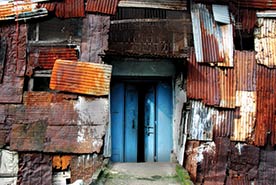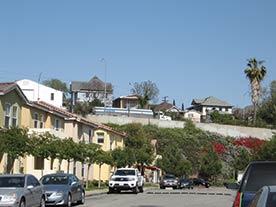
Photo by Tobias Leeger, CC BY-NC-ND
Sometimes to understand our own cities and community development practices it is helpful to understand a radically different setting. In the slums of Mumbai one thing is immediately evident: the Indian understanding of “slum” and the American one are radically different. Unlike the hyperghettos of the United States — spaces that are depopulated, run down, and crime-ridden — Mumbai’s slums are often safe and bustling hives of activity.
The structures of the slums are either self-made or built by a day laborer. They are densely packed and individual families tend to build vertically, adding lofts to accommodate family members or make extra money from rent. Running through the slums are very busy lanes that accommodate motorized, pedestrian, and animal traffic in a delicate, dangerous, and cacophonous dance. These streets are entirely lined with retail establishments: food sellers, tailors, shoe repairmen, chemists, optometrists, and hawkers of second-hand automotive parts or cell phones. In Mumbai’s Dharavi (often said to be the largest slum in Asia) there is a large section with industrial workshops as well, which recycle what ragpickers bring in, process leather, make pottery, or do embroidery. The biggest problem in iconic slums like Dharavi is an absence of services and infrastructure, most notably, indoor toilets.
The virtues of these slums are many. They are almost entirely self-organized and they are a testament to the ability of people to collectively solve problems without the help of large organizations like government, NGOs, or private firms. One local urban planning outfit refers to them as “wiki-cities” because of their user-generated character.
That such communities can exist at all is jarring for an American. We expect poor communities to suffer from a “culture of poverty” that undermines initiative and rewards predatory behavior. In policy, we attempt to distribute the poor in suburban communities where they will have better role models for appropriately striving behavior. The idea that the poor lack skills (rather than resources) is also a widely-held view. The assumptions behind these policies are at best problematic if not radically wrong. The expectation that the poor can simply mimic the affluent and become upwardly mobile by serving them coffee is expecting a lot. At the same time, the idea that poverty produces a debilitating culture (more than affluence does) is equally problematic, especially when we observe how the poor in other parts of the world construct their communities.
But it is not simply the industriousness of the people in these communities that is jarring, it is their spatial morphology as well. The stamp of the large organization is mostly missing. Streets bear no mark of the planner’s preference for right angles. Buildings bear no mark of an architect’s formal training, or of government zoning regulations and building codes. It looks chaotic and messy and would definitely not appeal to the young professional couple looking for an ordered environment in which to safely raise their children. It is a common anecdote in Mumbai that bureaucracies cover their mistakes by saying they can’t locate people living in these communities. And yet, these notices are somehow regularly delivered by the postman.
On the other hand, the limits of the wiki-city are immediately evident: they don’t have sewers, indoor running water, trash pickup, or electricity. There is no open space for recreation. These amenities are usually produced and maintained by large organizations and those organizations do not commit resources to illegal settlements occupied by cash-poor residents. Of course people tend to solve these problems on their own, though not always in ideal ways. Electricity is pirated. Politicians install community taps in exchange for votes (though there is still not enough water anywhere in the city), ragpickers collect at least some of the trash — indeed, the main lanes are relatively trash-free — and NGOs set up communal toilets (on a dues-paying membership model).
Wiki-City Versus Access to Bureaucracy
What can be learned from Mumbai’s slums? Lots. While the wiki-city metaphor is easily overdone, these slums succeed to the degree they do because of the capacities of the individuals who live in them and their expectation that they can solve problems together. Of course, they have no other choice in the matter.
In the United States the wiki-city is a rare phenomenon. Instead, we have highly developed bureaucratic systems and organizations that provide services and maintain the infrastructure of the city. The population fits this mold. We have skills that fill roles demanded by the labor market. This enables us to earn cash that we use to purchase the services we need.
Even in poor neighborhoods, few communities are “user-generated” in the sense that Mumbai’s slums are. Contemporary housing policy and standard community development practice in the United States is designed to connect people with these bureaucratic systems and the markets that often mediate transactions with them. Community developers connect people to various levels of government, banks, and by extension credit markets, local markets for goods and services, and employment markets.
This is often a necessary service. One thing that many agree characterizes American and European ghettos is their isolation from networks, resources, and jobs. Our communities simply lack the capacity to construct “wiki-cities.”
At the same time, there has been limited opportunity to try because of our assumption that goods should be provided by formal organizations in exchange for cash. Sheila Patel, a noted organizer of slum residents in Mumbai, reflects that when she came to America to talk with the urban poor she was struck by their desire to solve problems through impersonal transactions with professional service providers employed by bureaucratic organizations, rather than collectively — something that is simply not an option for the poor in India.
The alternative to building communities with greater capacity to solve local problems autonomously is to focus on income. After all, people need cash to get the services they need through impersonal transactions. However, income is usually most precisely addressed by labor unions and governments, not community developers. When community developers attempt to address the financial well being of community residents, they have traditionally focused on access to credit, not access to income. This was fine as long as people were earning incomes and could pay debt service. In the absence of income — structural unemployment has been a problem of varying severity since 1973 — the effect has been to expose many people to credit and default risk, as was made spectacularly evident in the foreclosure crisis.
For a long time, American community development practice has been mostly oriented to better equipping communities to integrate well with the broader society and economy. At the same time, there has been very little thought about how to produce better communities or how to teach the skills that might enable communities to figure it out on their own. Training for community residents is often focused on issues of civility and decorum in meetings, rather than on how to create a decentralized electrical grid, build and maintain buildings, produce food, and so on.
It wasn’t always this way. The original vision for community development was often to develop those resources within communities themselves, not connect people to resources outside of the community. The roots of community development in the 1970s provide many instructive examples of CDCs undertaking projects that focus on bettering communities, not just integration with markets and bureaucracies: cooperative businesses, tool banks and repair workshops, community gardens, housing coops that sometimes developed out of squats. Each of these endeavored to build community capacity to solve problems independently. In each of these examples, what makes a better community is not nicer, capital-intensive housing, but a community with greater capacity to shape itself in the ways that community members desire.
Lessons From Mumbai
The question is whether some lessons from the user-generated slums of Mumbai can be incorporated into American community development practice. This is a tricky proposition. The simple fact is most American urban dwellers don’t have the skill sets of poor Mumbaikars. Even if we did, most of us operate in a radically different regulatory environment — one which assumes that the most important work will be undertaken by specialized formal organizations. It is not as if we can simply expect people to start building their own houses. Even if they could, it would not be legally viable.
But moments and spaces of crisis, such as those that exist in the most persistently problematic American ghettos, do provide opportunities for experimentation. We need to imagine new and more expansive ways of developing communities that are less reliant on large organizations and markets to be successful. We need to be more attentive to community capacity. It is capacity that underpins more holistic solutions to community problems. (The contrast between this and American community developers who are prone to setting up community forums to discuss the appropriate width of porch overhangs could not be more stark.)
Community developers need to look to examples from overseas to rethink their practice. Or, if not that, they need to look to their past and reconsider what they did before focusing on capital-intensive housing redevelopment. Given the evident limitations and failures of the capital-intensive model, it’s time to return to the drawing board.






love the article
Dynamite article. I spent some years working as a service provider for public housing residents in Chicago (funding for our services came from the government) and what you say in this article is absolutely true. Here in the US, we encourage the impoverished to seek resources outside of their community rather than within it for solutions. I especially like your point “We expect poor communities to suffer from a “culture of poverty” that undermines initiative and rewards predatory behavior. In policy, we attempt to distribute the poor in suburban communities where they will have better role models for appropriately striving behavior. The idea that the poor lack skills (rather than resources) is also a widely-held view. The assumptions behind these policies are at best problematic if not radically wrong. The expectation that the poor can simply mimic the affluent and become upwardly mobile by serving them coffee is expecting a lot. At the same time, the idea that poverty produces a debilitating culture (more than affluence does) is equally problematic, especially when we observe how the poor in other parts of the world construct their communities.” Right on.